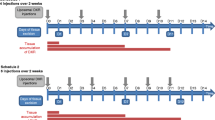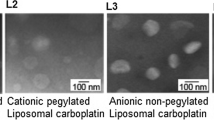Abstract
Liposomes, modified with monoclonal antibodies, are suitable carriers for targeted delivery of chemotherapeutic drugs into brain tumors. Here, we investigate the therapeutic efficacy of monoclonal anticancer antibody 2C5-modified long-circulating liposomes (LCL) loaded with doxorubicin (2C5-DoxLCL) for the treatment of U-87 MG human brain tumors in an intracranial model in nude mice. In vitro, 2C5-DoxLCL is significantly more effective in killing the U-87 MG tumor cells than Doxil® (commercial doxorubicin-loaded PEGylated LCL) or DoxLCL modified with a non-specific IgG. 2C5-immunoliposomes also demonstrate a significantly higher accumulation in U-87 MG tumors compared to all controls in a subcutaneous model. The treatment of intracranial U-87 MG brain tumors in nude mice with 2C5-DoxLCL provides a significant therapeutic benefit over control formulations, substantially reducing the tumor size and almost doubling the survival time. Thus, monoclonal antibody 2C5-modified LCL can specifically target the anticancer drugs to brain tumors, leading to improved therapeutic treatment of brain tumor in an intracranial model, in vivo.






Similar content being viewed by others
References
Amselem S, Gabizon A, Barenholz Y (1990) Optimization and upscaling of doxorubicin-containing liposomes for clinical use. J Pharm Sci 79:1045–1052
Badruddoja MA, Black KL (2006) Improving the delivery of therapeutic agents to CNS neoplasms: a clinical review. Front Biosci 11:1466–1478
Bradford R, Darling JL, Thomas DG (1989) The development of an animal model of glioma for use in experimental neuro-oncology. Br J Neurosurg 3:197–210
Bredel M (2001) Anticancer drug resistance in primary human brain tumors. Brain Res Brain Res Rev 35:161–204
Bredel M, Zentner J (2002) Brain-tumour drug resistance: the bare essentials. Lancet Oncol 3:397–406
Bullard DE, Schold SC Jr, Bigner SH, Bigner DD (1981) Growth and chemotherapeutic response in athymic mice of tumors arising from human glioma-derived cell lines. J Neuropathol Exp Neurol 40:410–427
Carrion C, de Madariaga MA, Domingo JC (2004) In vitro cytotoxic study of immunoliposomal doxorubicin targeted to human CD34(+) leukemic cells. Life Sci 75:313–328
Davies DC (2002) Blood–brain barrier breakdown in septic encephalopathy and brain tumours. J Anat 200:639–646
Enoch HG, Strittmatter P (1979) Formation and properties of 1000-A-diameter, single-bilayer phospholipid vesicles. Proc Natl Acad Sci USA 76:145–149
Fine HA, Dear KB, Loeffler JS, Black PM, Canellos GP (1993) Meta-analysis of radiation therapy with and without adjuvant chemotherapy for malignant gliomas in adults. Cancer 71:2585–2597
Gupta B, Levchenko TS, Mongayt DA, Torchilin VP (2005) Monoclonal antibody 2C5-mediated binding of liposomes to brain tumor cells in vitro and in subcutaneous tumor model in vivo. J Drug Target 13:337–343
Hong YK, Chung DS, Joe YA, Yang YJ, Kim KM, Park YS, Yung WK, Kang JK (2000) Efficient inhibition of in vivo human malignant glioma growth and angiogenesis by interferon-beta treatment at early stage of tumor development. Clin Cancer Res 6:3354–3360
Horowitz AT, Barenholz Y, Gabizon AA (1992) In vitro cytotoxicity of liposome-encapsulated doxorubicin: dependence on liposome composition and drug release. Biochim Biophys Acta 1109:203–209
Houchens DP, Ovejera AA, Riblet SM, Slagel DE (1983) Human brain tumor xenografts in nude mice as a chemotherapy model. Eur J Cancer Clin Oncol 19:799–805
Huang SK, Lee KD, Hong K, Friend DS, Papahadjopoulos D (1992) Microscopic localization of sterically stabilized liposomes in colon carcinoma-bearing mice. Cancer Res 52:5135–5143
Iakoubov LZ, Rokhlin OV, Torchilin VP (1995) Anti-nuclear autoantibodies of the aged reactive against the surface of tumor but not normal cells. Immunol Lett 47:147–149
Iakoubov LZ, Torchilin VP (1997) A novel class of antitumor antibodies: nucleosome-restricted antinuclear autoantibodies (ANA) from healthy aged nonautoimmune mice. Oncol Res 9:439–446
Iakoubov LZ, Torchilin VP (1998) Nucleosome-releasing treatment makes surviving tumor cells better targets for nucleosome-specific anticancer antibodies. Cancer Detect Prev 22:470–475
Kiaris H, Schally AV, Nagy A, Sun B, Szepeshazi K, Halmos G (2000) Regression of U-87 MG human glioblastomas in nude mice after treatment with a cytotoxic somatostatin analog AN-238. Clin Cancer Res 6:709–717
Krishna R, St-Louis M, Mayer LD (2000) Increased intracellular drug accumulation and complete chemosensitization achieved in multidrug-resistant solid tumors by co-administering valspodar (PSC 833) with sterically stabilized liposomal doxorubicin. Int J Cancer 85:131–141
Laccabue D, Tortoreto M, Veneroni S, Perego P, Scanziani E, Zucchetti M, Zaffaroni M, D’Incalci M, Bombardelli E, Zunino F, Pratesi G (2001) A novel taxane active against an orthotopically growing human glioma xenograft. Cancer 92:3085–3092
Lasch J, Weissig V, Brandl M (2003) Preparation of liposomes. In: Torchilin VP, Weissig V (eds) Liposomes: a practical approach. Oxford University, New York, pp 3–29
Levchenko TS, Rammohan R, Lukyanov AN, Whiteman KR, Torchilin VP (2002) Liposome clearance in mice: the effect of a separate and combined presence of surface charge and polymer coating. Int J Pharm 240:95–102
Lukyanov AN, Elbayoumi TA, Chakilam AR, Torchilin VP (2004) Tumor-targeted liposomes: doxorubicin-loaded long-circulating liposomes modified with anti-cancer antibody. J Control Release 100:135–144
Maeda H, Sawa T, Konno T (2001) Mechanism of tumor-targeted delivery of macromolecular drugs, including the EPR effect in solid tumor and clinical overview of the prototype polymeric drug SMANCS. J Control Release 74:47–61
Mamot C, Drummond DC, Greiser U, Hong K, Kirpotin DB, Marks JD, Park JW (2003) Epidermal growth factor receptor (EGFR)-targeted immunoliposomes mediate specific and efficient drug delivery to EGFR- and EGFRvIII-overexpressing tumor cells. Cancer Res 63:3154–3161
Mayer LD, Shabbits JA (2001) The role for liposomal drug delivery in molecular and pharmacological strategies to overcome multidrug resistance. Cancer Metastasis Rev 20:87–93
Mayer LD, Tai LC, Bally MB, Mitilenes GN, Ginsberg RS, Cullis PR (1990) Characterization of liposomal systems containing doxorubicin entrapped in response to pH gradients. Biochim Biophys Acta 1025:143–151
Ozawa T, Wang J, Hu LJ, Bollen AW, Lamborn KR, Deen DF (2002) Growth of human glioblastomas as xenografts in the brains of athymic rats. In Vivo 16:55–60
Ozawa T, Wang J, Hu LJ, Lamborn KR, Bollen AW, Deen DF (1998) Characterization of human glioblastoma xenograft growth in athymic mice. In Vivo 12:369–374
Park JW, Hong K, Kirpotin DB, Papahadjopoulos D, Benz CC (1997) Immunoliposomes for cancer treatment. Adv Pharmacol 40:399–435
Pastorino F, Brignole C, Marimpietri D, Sapra P, Moase EH, Allen TM, Ponzoni M (2003) Doxorubicin-loaded Fab’ fragments of anti-disialoganglioside immunoliposomes selectively inhibit the growth and dissemination of human neuroblastoma in nude mice. Cancer Res 63:86–92
Rautioa J, Chikhale PJ (2004) Drug delivery systems for brain tumor therapy. Curr Pharm Des 10:1341–1353
Reardon DA, Rich JN, Friedman HS, Bigner DD (2006) Recent advances in the treatment of malignant astrocytoma. J Clin Oncol 24:1253–1265
Samokhin GP, Mongayt DA, Iakoubov LZ, Levchenko TS, Torchilin VP (2001) Negatively charged polymers protect antinuclear antibody against inactivation by acylating agents. Anal Biochem 292:245–249
Sharma US, Sharma A, Chau RI, Straubinger RM (1997) Liposome-mediated therapy of intracranial brain tumors in a rat model. Pharm Res 14:992–998
Siegal T, Horowitz A, Gabizon A (1995) Doxorubicin encapsulated in sterically stabilized liposomes for the treatment of a brain tumor model: biodistribution and therapeutic efficacy. J Neurosurg 83:1029–1037
Torchilin VP, Lukyanov AN, Gao Z, Papahadjopoulos-Sternberg B (2003) Immunomicelles: targeted pharmaceutical carriers for poorly soluble drugs. Proc Natl Acad Sci USA 100:6039–6044
Vajkoczy P, Menger MD (2000) Vascular microenvironment in gliomas. J Neurooncol 50:99–108
Wu NZ, Da D, Rudoll TL, Needham D, Whorton AR, Dewhirst MW (1993) Increased microvascular permeability contributes to preferential accumulation of Stealth liposomes in tumor tissue. Cancer Res 53:3765–3770
Yuan F, Leunig M, Huang SK, Berk DA, Papahadjopoulos D, Jain RK (1994) Microvascular permeability and interstitial penetration of sterically stabilized (stealth) liposomes in a human tumor xenograft. Cancer Res 54:3352–3356
Acknowledgment
This work was supported by NIH RO1 HL55519 grant to Vladimir P. Torchilin.
Author information
Authors and Affiliations
Corresponding author
Rights and permissions
About this article
Cite this article
Gupta, B., Torchilin, V.P. Monoclonal antibody 2C5-modified doxorubicin-loaded liposomes with significantly enhanced therapeutic activity against intracranial human brain U-87 MG tumor xenografts in nude mice. Cancer Immunol Immunother 56, 1215–1223 (2007). https://doi.org/10.1007/s00262-006-0273-0
Received:
Accepted:
Published:
Issue Date:
DOI: https://doi.org/10.1007/s00262-006-0273-0




